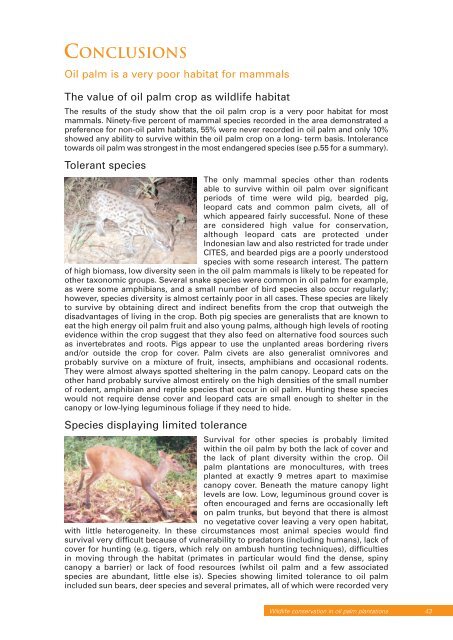The conservation of tigers and other wildlife in oil palm plantations
The conservation of tigers and other wildlife in oil palm plantations
The conservation of tigers and other wildlife in oil palm plantations
Create successful ePaper yourself
Turn your PDF publications into a flip-book with our unique Google optimized e-Paper software.
CONCLUSIONS<br />
Oil <strong>palm</strong> is a very poor habitat for mammals<br />
<strong>The</strong> value <strong>of</strong> <strong>oil</strong> <strong>palm</strong> crop as <strong>wildlife</strong> habitat<br />
<strong>The</strong> results <strong>of</strong> the study show that the <strong>oil</strong> <strong>palm</strong> crop is a very poor habitat for most<br />
mammals. N<strong>in</strong>ety-five percent <strong>of</strong> mammal species recorded <strong>in</strong> the area demonstrated a<br />
preference for non-<strong>oil</strong> <strong>palm</strong> habitats, 55% were never recorded <strong>in</strong> <strong>oil</strong> <strong>palm</strong> <strong>and</strong> only 10%<br />
showed any ability to survive with<strong>in</strong> the <strong>oil</strong> <strong>palm</strong> crop on a long- term basis. Intolerance<br />
towards <strong>oil</strong> <strong>palm</strong> was strongest <strong>in</strong> the most endangered species (see p.55 for a summary).<br />
Tolerant species<br />
<strong>The</strong> only mammal species <strong>other</strong> than rodents<br />
able to survive with<strong>in</strong> <strong>oil</strong> <strong>palm</strong> over significant<br />
periods <strong>of</strong> time were wild pig, bearded pig,<br />
leopard cats <strong>and</strong> common <strong>palm</strong> civets, all <strong>of</strong><br />
which appeared fairly successful. None <strong>of</strong> these<br />
are considered high value for <strong>conservation</strong>,<br />
although leopard cats are protected under<br />
Indonesian law <strong>and</strong> also restricted for trade under<br />
CITES, <strong>and</strong> bearded pigs are a poorly understood<br />
species with some research <strong>in</strong>terest. <strong>The</strong> pattern<br />
<strong>of</strong> high biomass, low diversity seen <strong>in</strong> the <strong>oil</strong> <strong>palm</strong> mammals is likely to be repeated for<br />
<strong>other</strong> taxonomic groups. Several snake species were common <strong>in</strong> <strong>oil</strong> <strong>palm</strong> for example,<br />
as were some amphibians, <strong>and</strong> a small number <strong>of</strong> bird species also occur regularly;<br />
however, species diversity is almost certa<strong>in</strong>ly poor <strong>in</strong> all cases. <strong>The</strong>se species are likely<br />
to survive by obta<strong>in</strong><strong>in</strong>g direct <strong>and</strong> <strong>in</strong>direct benefits from the crop that outweigh the<br />
disadvantages <strong>of</strong> liv<strong>in</strong>g <strong>in</strong> the crop. Both pig species are generalists that are known to<br />
eat the high energy <strong>oil</strong> <strong>palm</strong> fruit <strong>and</strong> also young <strong>palm</strong>s, although high levels <strong>of</strong> root<strong>in</strong>g<br />
evidence with<strong>in</strong> the crop suggest that they also feed on alternative food sources such<br />
as <strong>in</strong>vertebrates <strong>and</strong> roots. Pigs appear to use the unplanted areas border<strong>in</strong>g rivers<br />
<strong>and</strong>/or outside the crop for cover. Palm civets are also generalist omnivores <strong>and</strong><br />
probably survive on a mixture <strong>of</strong> fruit, <strong>in</strong>sects, amphibians <strong>and</strong> occasional rodents.<br />
<strong>The</strong>y were almost always spotted shelter<strong>in</strong>g <strong>in</strong> the <strong>palm</strong> canopy. Leopard cats on the<br />
<strong>other</strong> h<strong>and</strong> probably survive almost entirely on the high densities <strong>of</strong> the small number<br />
<strong>of</strong> rodent, amphibian <strong>and</strong> reptile species that occur <strong>in</strong> <strong>oil</strong> <strong>palm</strong>. Hunt<strong>in</strong>g these species<br />
would not require dense cover <strong>and</strong> leopard cats are small enough to shelter <strong>in</strong> the<br />
canopy or low-ly<strong>in</strong>g legum<strong>in</strong>ous foliage if they need to hide.<br />
Species display<strong>in</strong>g limited tolerance<br />
Survival for <strong>other</strong> species is probably limited<br />
with<strong>in</strong> the <strong>oil</strong> <strong>palm</strong> by both the lack <strong>of</strong> cover <strong>and</strong><br />
the lack <strong>of</strong> plant diversity with<strong>in</strong> the crop. Oil<br />
<strong>palm</strong> <strong>plantations</strong> are monocultures, with trees<br />
planted at exactly 9 metres apart to maximise<br />
canopy cover. Beneath the mature canopy light<br />
levels are low. Low, legum<strong>in</strong>ous ground cover is<br />
<strong>of</strong>ten encouraged <strong>and</strong> ferns are occasionally left<br />
on <strong>palm</strong> trunks, but beyond that there is almost<br />
no vegetative cover leav<strong>in</strong>g a very open habitat,<br />
with little heterogeneity. In these circumstances most animal species would f<strong>in</strong>d<br />
survival very difficult because <strong>of</strong> vulnerability to predators (<strong>in</strong>clud<strong>in</strong>g humans), lack <strong>of</strong><br />
cover for hunt<strong>in</strong>g (e.g. <strong>tigers</strong>, which rely on ambush hunt<strong>in</strong>g techniques), difficulties<br />
<strong>in</strong> mov<strong>in</strong>g through the habitat (primates <strong>in</strong> particular would f<strong>in</strong>d the dense, sp<strong>in</strong>y<br />
canopy a barrier) or lack <strong>of</strong> food resources (whilst <strong>oil</strong> <strong>palm</strong> <strong>and</strong> a few associated<br />
species are abundant, little else is). Species show<strong>in</strong>g limited tolerance to <strong>oil</strong> <strong>palm</strong><br />
<strong>in</strong>cluded sun bears, deer species <strong>and</strong> several primates, all <strong>of</strong> which were recorded very<br />
Wildlife <strong>conservation</strong> <strong>in</strong> <strong>oil</strong> <strong>palm</strong> <strong>plantations</strong> 43

















